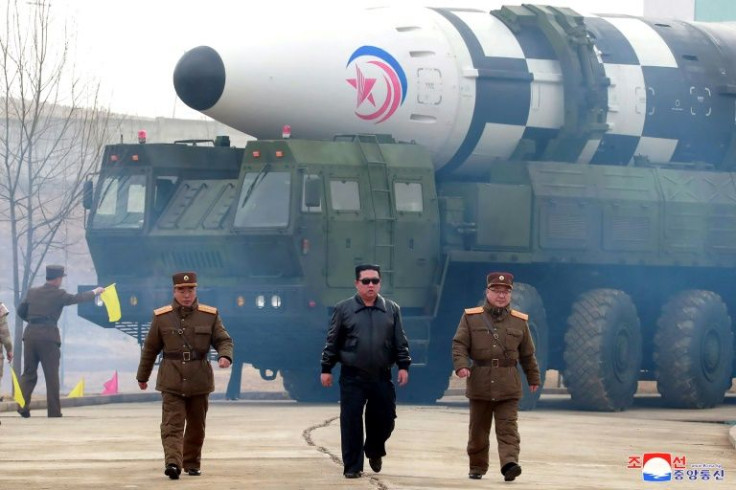Amid North's Missile Tests Warning US And South Korea, Reports Say Pyongyang's ICBM Launch Failed
KEY POINTS
- The Hwasong-17 missile is North Korea's newest known ICBM variant
- North Korea had warned of "more powerful follow-up measures" in response to the joint military drill by the U.S. and South Korean forces
- Following the failed test, Washington and Seoul agreed to extend their joint exercises
Following its warning against the U.S. and South Korea's joint military drills Tuesday, North Korea carried out a barrage of weapon tests Wednesday and Thursday, launching multiple-range missiles and shells to the east and west of the Korean Peninsula. Reports now claim that the said tests included a failed launch of an intercontinental ballistic missile (ICBM).
While North Korea fired at least 23 short-range missiles of varying types Wednesday, logging the highest number of short-range missiles fired in a single day, a CNN report citing an unnamed South Korean government source said Pyongyang on Thursday launched its newest Hwasong-17 ICBM that failed and fell into the sea between the Korean Peninsula and Japan.
Pyongyang had warned of "more powerful follow-up measures" in response to the five-day, Vigilant Storm joint air exercise by the U.S. and South Korean forces that began Monday, featuring about 240 warplanes conducting about 1,600 sorties.
Confirming the reported launch of the Hwasong-17, South Korea's Yonhap News Agency, citing the country's Joint Chiefs of Staff (JCS), said the ICBM was launched from the Sunan area in Pyongyang at around 7:40 a.m. (10:40 GMT).
According to the news agency, the missile flew about 760 kilometers (about 470 miles) at an apogee of around 1,920 kilometers (over 1190 miles) at a top speed of Mach 15. After the second stage separation, the ICBM seemed to have failed in normal flight.
Following the launch of the ICBM, South Korea also detected the firing of two short-range ballistic missiles (SRBMs) from Kaechon in South Pyongan Province, which traveled some 330 kilometers (approx. 205 miles) at a maximum altitude of around 70 kilometers (around 43 miles) at a top speed of Mach 5, Yonhap News Agency reported.
Meanwhile, Japan also confirmed that of the three missiles fired, one disappeared from radar over the Sea of Japan. Japanese Defense Minister Yasukazu Hamada told reporters, "We are still investigating the cause of its disappearance."
Within hours of the supposed failed test, Washington and Seoul agreed to extend their joint exercises to an unknown date. Quoting a statement from the South Korean Air Force, the CNN report said, "It was necessary to demonstrate a solid combined defense posture of the bilateral alliance under the current security crisis, heightened by North Korea's provocations."
In March, North Korea fired a suspected intercontinental ballistic missile (ICBM) toward the sea off its east coast. It was believed to be its first ICBM test since 2017. State media later announced that it was the launch of a Hwasong-17 missile, the country's newest known ICBM variant.
Described as the "powerful nuclear war deterrent" by local media, the Hwasong-17 puts the entire U.S. mainland in striking range of a North Korean nuclear warhead. However, a lot remains unknown about the missile's capability.
The latest provocation from Pyongyang comes amid Washington's accusations that North Korea is secretly sending Russia a "significant number" of artillery shells to help in its war in Ukraine.
Following reports that Moscow was turning to pariah states like Iran and North Korea to buy shells and rockets, Pyongyang earlier denied that it has been supplying weapons and ammunition to Russia, terming the allegations as "rumors" spread by "hostile forces" aimed at tarnishing the country's image.

© Copyright IBTimes 2025. All rights reserved.






















